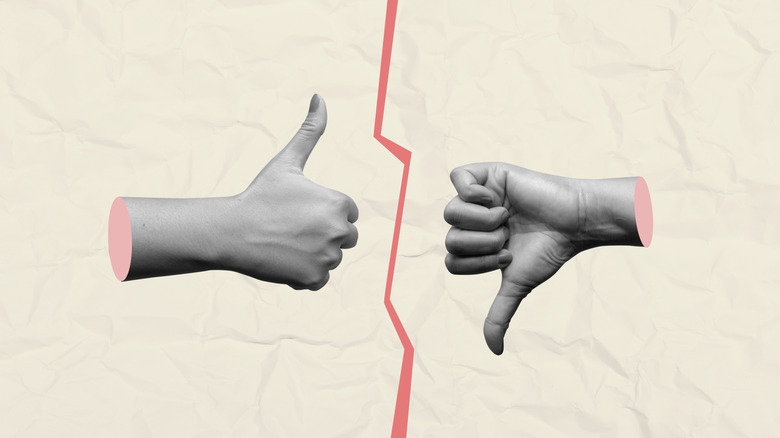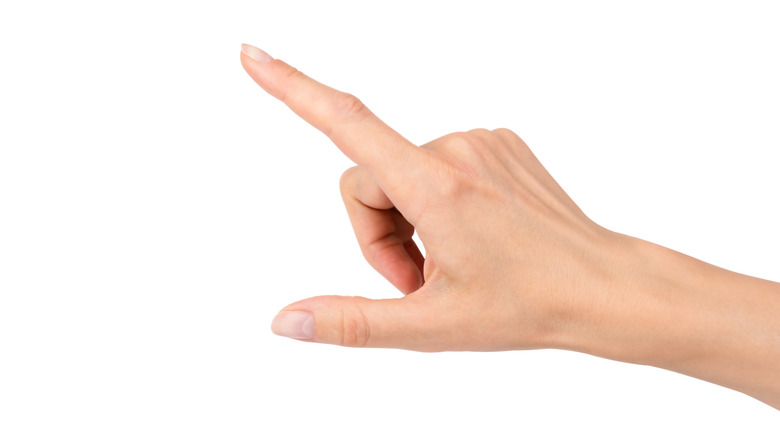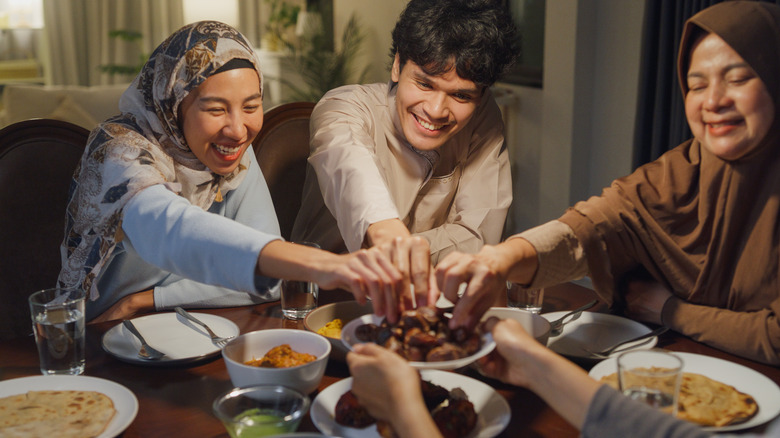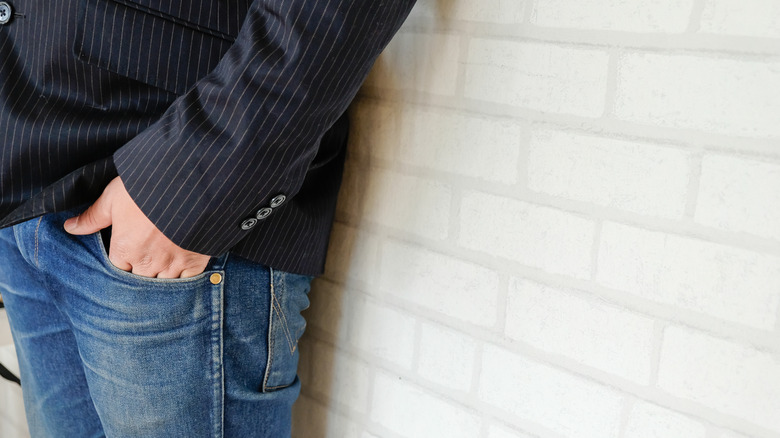15 Everyday Gestures You Should Never Use Abroad
Culture is a funny thing. At its core, it's nothing more than a set of made-up suggestions for living life in any given corner of the world. At its broadest and most important, culture is a vital piece of national identity and a gateway to experiencing a place. Formed by an impossibly vast number of variables over thousands of years, differing cultures make simple everyday experiences, from talking on the phone to grabbing a drink at the pub to using the toilet, feel drastically different — sometimes just a few miles apart. But while some cultural quirks are well documented and expected, others can be a little harder to grasp at first — and even offensive if not observed.
Little things, like waves or nods, are gestures that feel second nature at home but can have immensely different meanings abroad. What feels friendly in one country might spark offense, confusion, or even laughter somewhere else. These subtle cultural differences often catch travelers off guard, but they're also part of what makes exploring the world fascinating.
Culture shock can be very real (and Rick Steve's prescription for it is brilliantly simple). But for most of us, it's found in the more direct aspects of travel, like learning to use chopsticks or discovering your first squatting toilet. But nonverbal cues can matter as much as bigger gestures, language, and effort. A local may find amusement in your attempts to use a different bathroom style, but they find genuine offense in the handshake you attempt later on. In a world that's increasingly connected, a little awareness goes a long way toward showing respect and curiosity instead of ignorance. Whether it's the way you beckon a waiter, cross your fingers for luck, or pose for a photo, these are the everyday gestures travelers should think twice about — and what they mean where you're going.
Thumbs up
In the U.S. and much of Europe, the thumbs-up is the universal signal for "all good." But in parts of the Middle East and Africa, as well as in Italy and Greece, it's far from friendly. In fact, it's closer to giving someone the middle finger. Travelers who flash it innocently at a taxi driver in Iran or North Africa could get puzzled or even offended looks in return.
Exactly how this divide happened is hard to pin down. It's been widely believed for years that a thumbs-up signal was rooted in the Roman gladiator pits, where the highest-ranking official would give a thumbs-up or down for mercy or death, respectively. More recently, however, that thinking has been reversed, and it's now believed a hidden thumb meant life, while a thumb up meant death. With this theory, the Middle Eastern feelings are more likely to stem from the Roman era. The first documented use of a thumbs-up as a positive gesture comes from British soldiers and pilots in World War I, who used it to signal they were okay or ready to fly.
Interestingly, as cultures are mingling more than ever before, thanks to social media and the internet, many cultures are softening to the thumbs-up gesture. With that in mind, younger people in these countries may be less bothered, but it's still worth being careful. And that applies to your emojis, too.
The OK sign
Picture the scene: You're halfway through a doner kebab in Istanbul, face stuffed with glee as the store owner swings by to check on you. Your mouth still full with food and not wanting to be rude, you throw your hand up with thumb and forefinger joining in a circle, with the other three pointing up. You're telling him the food is perfect. But he understands it as a homophobic slur.
In today's world — and in a place with so many tourists — there's a good chance they'll understand you didn't mean offense. Still, you can't assume that. At the very least, it's likely to spark an awkward conversation. In Germany and France, it's also used to say someone is " a zero" or "worth nothing", but this is slowly being replaced depending on what part of the country you're in. Context will play a part in those countries, but not so much in Turkey.
Oddly, the gesture has taken on a darker meaning in recent years, after an online hoax designed to troll people with left-leaning political views suggested the sign stood for "white power". The initial idea went viral and, at its peak, was even flashed by the Christchurch massacre suspect — a white man convicted of killing over 50 Muslims. While the hysteria has died down, some are still connecting the gesture to white nationalism. Overall, it's not something you need to worry about, but it's a fascinating example of how gestures can shift meaning in real time.
The V Sign (Palm Inward)
As a Brit myself, this one is close to my heart — and it's a common American gesture to avoid in Britain. To most of the world, this common gesture is the symbol for peace or even V for Victory, thanks to Winston Churchill's use of it during World War II. But in the U.K., throwing two fingers up with your palm facing in is equivalent to the middle finger.
It's important to clarify that two fingers facing out still means "peace" or "victory" to us, but turning your hand around is most definitely an insult. The exact origins of the gesture are a little murky, but it's widely believed (albeit unproven) that it stretches back centuries to the many medieval wars between England and France. Legend has it that French troops would cut off the index and middle fingers of the captured and (at the time) superior English archers. Because of this, when French archers were captured, the English would taunt them by showing their two-fingered salute. Amusingly, Winston Churchill would have known the gesture's meaning, leading some historians to suggest that his famous "victory" symbols were telling the Germans where to go.
The U.S. cultural dominance means the middle finger is also used in the British Isles, so don't assume you'll get away with that. Thankfully, the Brits have a fairly dry sense of humor, and it's unlikely that you'll cause any real offense by doing it in a photo.
Beckoning with a finger
The United States is pretty much alone in this one. Beckoning someone to you with a curled index finger might be fine for Americans, but in many parts of Asia, Africa, and Europe, it's considered demeaning. Even in Western countries like the U.K., which shares many sentimentalities with the U.S., it's rarely used beyond a parent summoning a naughty child — and in that case, it's meant to be a little intimidating.
In Asia, it's a gesture reserved for summoning animals, not people, so definitely avoid it in restaurants on that side of the world. In the East, gesturing to someone by putting your palm down and motioning your entire hand is far more polite. In restaurants in the West, anything from a little wave or a full arm beckoning offers much more respect.
In touristy areas, locals might be a little less bothered, as they'll be used to the cultural differences, but do your best to remember and be a good visitor.
Pointing
If there's one gesture that feels truly instinctive, it's pointing. You see something, you lift your finger. But in Malaysia, Japan, and Indonesia, that simple action can seem abrupt or aggressive. In these countries, etiquette leans toward subtlety. An open hand or a slight tilt of the head replaces what many Westerners would consider a harmless jab in the air. With that said, you should also avoid this common American gesture at all costs in Greece.
Of course, there's nuance here. Pointing isn't universally polite in the U.S. either. Pointing at people is almost always considered impolite — what's the saying? "Point one at me, you're pointing four back at yourself." But even pointing at objects or signs can come off as a little brusque in these countries. The cultural roots lie in values of humility and indirectness, and these extend to things as well as people. It's good practice to take a tour early on and watch how guides gesture to things. Not only can you see it in action, but these are the best people to ask for clarification.
Crossing fingers
Crossing your fingers for luck feels harmless. You've done it in the last moments of your favorite team's final, or as you wait to receive exam results. But if you haven't already caught the drift of this article, it might cause some issues elsewhere in the world.
Some European countries, like Germany, don't use it for luck. Instead, it's a gesture that suggests you're lying. This also seeps into the U.S. and the U.K., as seen when kids cross their fingers behind their backs when fibbing. Amusingly, in Germany and some Slavic countries, people hold their thumb for luck instead.
Overall, you won't cause too much offense in these countries, though. Vietnam, on the other hand, is a different beast altogether. In the popular Southeast Asian country, crossed fingers are a vulgar reference to female anatomy — and it's not tolerated at all. Avoid using the gesture there and sidestep any awkward interactions. Asians from other countries may find it confusing, but they won't take offense.
Showing the soles of your feet
In many parts of the Middle East and Asia, the feet are viewed as the lowest and dirtiest part of the human body. With this in mind, showing your soles or pointing your feet at someone can be seen as extremely disrespectful.
This doesn't just mean when you're barefoot, either. Whether you're crossing a leg over the other on the train or propping them up on a bollard outside, the soles of your shoes shouldn't be seen. This goes hand-in-hand with placing your feet on chairs. Let's be frank, you shouldn't be doing that anyway, but in the Middle East, you'll be seen as uncouth at best.
It's also good practice to take your shoes off before entering anyone's home. Depending on the country and whether it's a preorganized event, some families may be more relaxed about this, but in general, the same respect should be applied.
Using the left hand
One of the trickiest customs to remember when traveling in some parts of the world relates to which hand you use. In certain places, including India, parts of Africa, and the Middle East, the left hand is traditionally associated with hygiene. In case you haven't put it together, it's the hand you use for personal hygiene.
As such, the left hand is never used for eating, greeting, or giving gifts. Offering money or food with your left hand can be taken as an insult, and you're likely to get some weird looks around the dinner table if you start eating with it. Travelers should remember this, especially when sharing meals or visiting rural areas. Left and right come into play when visiting shrines in Japan, too — though not in terms of which hand to use. When in doubt, use the right. It's much better to be safe than sorry.
Patting someone on the head
While the feet are viewed as dirty in some cultures, the opposite is true in Thailand and other Buddhist nations. The head is viewed as sacred, or as the "seat of the spirit". Because of this, touching someone's head, even with affection, is viewed as deeply disrespectful. It's a cultural contrast, as elders in India bless their young by lightly touching their head. Either way, it's best to avoid patting anyone on the head.
Thankfully, patting someone on the head isn't something most people do casually — unless they're being a little condescending. But it is pretty normal to pat a child's head or affectionately ruffle their hair. This is a gesture that's not likely to come up very often, but one that could cause a serious amount of confusion for you if you were caught unaware.
Handshake variations
Handshakes are a funny quirk in Western societies. The over-reliance on the concept of a firm shake being a sign of confidence can lead to some painful, knuckle-crushing introductions, but it's unlikely to ruffle any feathers. Abroad, however, it's a different story.
In Japan, it's often normal to forgo a handshake, replacing what can be seen as an assertive gesture with a bow — a more respectful greeting. In India, they may shake hands, but it's likely to be more of a gentle clasp along with a "namaste" instead of a vice-grip with hard eye contact.
And in many Muslim countries, it's often seen as taboo for a man to shake a woman's hand. While this might rub you the wrong way from an equality standpoint, these are cultural norms that should be respected. In any case, the best way to ensure there are no issues is to follow the lead of those around you.
The horns sign
In the U.S., throwing the horns sign up at a rock concert or even in a photo on a night out is usually just seen as a sign of enthusiasm. Its role in the music scene, specifically heavy metal, is tied to Ronnie James Dio, a frontman for several metal bands in the 1960s, 1970s, and 1980s. He began using the sign onstage after learning it from his Italian grandmother, who supposedly used it to ward off evil spirits. Since then, it's been adopted by the rock scene and can be seen at virtually any event with an electric guitar present. It's also similar to "I love you" in ASL (American Sign Language), although the thumb needs to be pointing out for this.
But it's also the one-handed gesture you should never make in Italy. Why? In some countries in the Mediterranean, it has a markedly darker connotation that you'd do well to avoid implying. For Italians, Greeks, and Spaniards, the sign implies that a man's partner has been unfaithful to him. It's known as "the corna".
As cultures become more entwined, it's likely that even at a rock concert in these countries, you'll still see it being used. But in smaller towns or rural areas, it may still have some negative connotations. Not that you'd be throwing them up at someone casually, anyway.
Hand in pocket while talking
Standing with your hand in your pocket might look casual to Americans, but in Japan, South Korea, and Turkey, it's perceived as rude or arrogant. The gesture suggests a lack of respect — something a Japanese prime minister's aide was once publicly criticized for — and it's not an impression you want to make while traveling. Yes, don't even do it if your hands are cold or if you're feeling a little chilly. It doesn't matter how long you have your hands in your pockets; it's more the gesture itself that's deemed disrespectful.
This is especially true when speaking with elders, officials, or hosts, as many of these countries have stricter social hierarchies than we're used to. I know it's tough knowing what to do with your hands sometimes, but to avoid upsetting anyone, keep your posture open and your hands visible.
Whistling
A cheerful tune while walking might seem harmless to you, but do it in the wrong place, and you may have just unwittingly cursed someone to financial ruin.
Alright, that may be a slight exaggeration, but it's not too far off the mark. In Russia and some other Slavic countries, whistling indoors is considered bad manners. Worse still, it's supposed to invite spirits to enter the home on an evil wind and take all the money. Sailors also don't whistle out of fear of bringing rough winds. Some even say that whistling indoors can make you lose your memory along with your money. Of course, this is superstition, but these long-held beliefs, however diluted in the modern world, do still mean the act appears rude to most.
Chopsticks etiquette
As if learning how to use chopsticks wasn't enough stress for your trip, now you have to learn about how you might offend someone with them. Unfortunately, too many tourists make this dining faux pas when visiting Japan and China. Japan and China have detailed chopstick etiquette. Sticking them upright in rice resembles funeral offerings, while passing food from chopstick to chopstick mimics a cremation ritual. Both are deeply taboo.
Again, this is something that a local may forgive, as it's unlikely you'd know about these specific customs. But making the effort to learn and understand can go a long way in bridging cultural gaps. When in doubt, lay your chopsticks across the bowl neatly. Locals will appreciate the effort, and you'll avoid any unintentional faux pas.
Nodding vs. shaking head
This is where things get confusing. Nodding and shaking heads, you'd think, would be a universal concept. Yet somewhere along the line, the opposite happened. Greeks and Bulgarians opted for a more nuanced system, where "yes" is signified by a single downward head nod, while "no" is signaled by a slight head movement upwards, sometimes accompanied by a tongue click. This can be confusing for foreigners, so it's best to seek verbal confirmation in any scenario.
In India, the infamous head wobble is a constant source of confusion. The side-to-side movement generally means yes, with more intense wobbles signifying a more enthusiastic response. Sometimes it may also mean "okay" or "maybe," and some might find it hard to decipher what the head nod actually means. I won't go into the details of it, but it's a heavily debated topic.
Methodology
Research for this article consisted of reading several different sources. This included major news outlets, niche cultural sites, and anthropological societies, to determine which gestures may have an offensive meaning in different countries or regions.
















